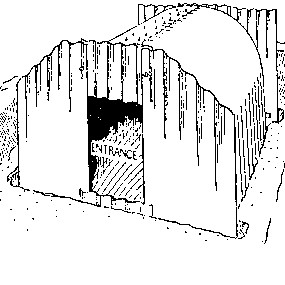Have you discovered an Anderson shelter in your garden?
There are broadly speaking three types of shelter still in existence:
FIRST, Is the shelter still in its its original wartime location, dug into the ground (or set in a concrete base) and covered in earth but not reinforced or covered by concrete? These shelters are very rare so I hope you will try to preserve yours. I would be delighted if you would send me photos so that I can feature it on this website. Your local historical society may also be interested to hear of it. And local schools might be very keen to arrange visits.
I don’t of any organisation that could help you financially or practically. But preserving or even rebuilding your shelter should not be difficult if you or your friends have basic practical skills. Indeed, lots of ordinary households built their own shelters during the war with material provided by the authorities
You will find information about how to repair and preserve your shelter here. I do not have any information or advice beyond what is on that page. But I would of course be glad to add any of your tips or useful experience you have.
SECOND, Is the shelter still in its its original wartime location, dug into the ground or set in a concrete base, but also reinforced or covered by concrete?
These shelters are also very rare, so I hope you will try to preserve yours. Again, your local historical society may also be interested to hear of it and local schools might want to arrange visits. As these are not the primary subject of this website please do not send me any photos or other information. You may, however, like to join the Facebook Group ‘Anderson Shelter in your garden‘.
I don’t know any organisation that can help you preserve your shelter, either financially or practically. If you try renovating it yourself, please take great care as the concrete roofs are very heavy.
THIRD, was your shelter recycled or re-used after the war? Many were turned into garden sheds, for instance. If so, then it is still a very interesting structure, which you might like to preserve. As these are not the primary subject of this website please do not send me any photos or other information. You may, however, like to join the Facebook Group ‘Anderson Shelter in your garden‘.
If you don’t want to keep the corrugated iron from your shelter, please don’t throw it away. At 2mm, the gauge used for Anderson shelters was significantly thicker than that manufactured today (around 0.7mm) and is hard to find so try to pass it on to others using eBay or Gumtree or advertise it via the Facebook group ‘Anderson Shelter in your garden‘.
